
What is ADHD?
Attention-Deficit Hyperactivity Disorder, also called ADHD, is a chronic condition including attention difficulty, hyperactivity, and impulsiveness. It is one of the most common mental disorders affecting children. But, ADHD also affects many adults. Symptoms of ADHD include inattention (not being able to keep focus), hyperactivity (excess movement that is not fitting to the setting) and impulsivity (hasty acts that occur in the moment without thought).
An estimated 5 percent of children and 2.5 percent of adults have ADHD. It is more common among boys than girls. It is often first identified in school-aged children when it leads to disruption in the classroom or problems with schoolwork. But, just because you may have a disruptive child in class, does not mean that they have ADHD.
ADHD can be confusing, inconsistent, and frustrating to diagnose within yourself and to live with. It is overwhelming to people who live with it every day. The diagnostic criteria that has been previously used has left many people wondering whether they have the condition or not. The Diagnostic and Statistical Manual of Mental Disorders , used by most diagnosticians, has a list of 18 criteria, and other symptom lists cite as many as 100 traits. But, it turns out that ADHD can be detected through brain imaging. Certain areas in the nervous system of someone with ADHD light up more often than it does in a neurotypical person. It’s not that those with the condition have a shortage of attention, but that they pay too much attention to everything. Most people with unmedicated ADHD have four or five things going on in their minds at once. It’s been noted that it feels like there’s a non-stop array of thoughts flowing through their mind.
Think about how you feel when you’re trying to go to sleep at night, and every thought known to man seems to be popping into your head. All of a sudden your mind is on hyper mode. Now, imagine that feeling lasting all day long.
Science Daily and Healthline.com posted an article about brain differences in ADHD people versus a neurotypical mind earlier this year, connecting to a recently published journal off “The Lancet”, titled “Subcortical brain volume differences in participants with attention deficit hyperactivity disorder in children and adults: a cross-sectional mega-analysis”. Huffington post named it the largest imaging study done by scientist on ADHD. This journal is causing scientists to say that maybe we should start looking at ADHD as less of a solely behavioral disorder but a neurological one as well. Although there are still ways to go in research involving ADHD, this study has been answering a lot of previous questions.
A team of Dutch neuroscientists studied the MRI scans of the brains of more than 3,200 people between the ages of four and 63 years old. They measured the total brain volume as well as the volume of seven brain regions thought to be linked to ADHD. The brain scans revealed that five brain regions were smaller in people with ADHD. These included the amygdala, an almond-shaped structure involved in processing emotions like fear and pleasure, the hippocampus, which plays a role in learning, memory and emotion, and three brain areas within the striatum: the caudate nucleus, the putamen and the nucleus accumbent. Roughly half of the participants had a diagnosis of ADHD.
The areas within the striatum mentioned are areas involved in the brain’s reward system and processing of dopamine, a neurotransmitter that helps control motivation and pleasure. Scientists then concluded that delayed brain development was more dramatic in children than it was in adults. But found that as the child matures, those areas in the brain that lacked prior begin to play “catch up” with the brains on non-ADHD people, and medication had no effect on the volume of the brains tested. Whether or not the test subjects had taken medication in the past to combat ADHD symptoms did not effect the volume of the brain. These are medications like Adderall, and other psychostimulants used to treat ADHD.




